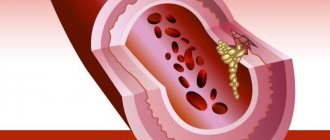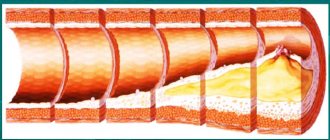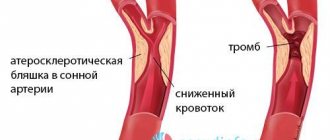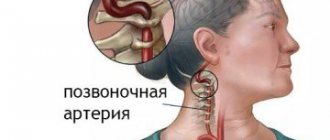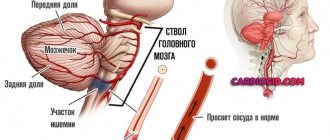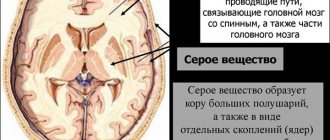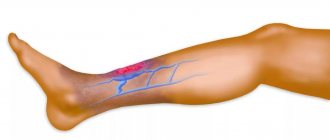Generalized atherosclerosis is a vascular disease accompanied by the appearance of atherosclerotic plaques. In this case, the lesion can be observed in several groups of vessels at once. This pathological process usually has a chronic form; it is based on impaired lipid metabolism. Complications arising from the disease threaten the health and life of the patient. Let's look at what kind of ailment this is, in more detail, and also figure out what the treatment is.
For what reasons does the disease develop?
The main cause of generalized atherosclerosis is considered to be excess cholesterol. Lipids are formed from fats that come with food.
This pathology can develop due to:
- A diet containing large amounts of cholesterol.
- Overeating.
- Excess weight.
- Sedentary lifestyle.
- Alcohol abuse.
- Smoking.
- Taking steroid hormonal drugs in large dosages.
- Chronic stress.
Other factors that are quite difficult to influence include:
- Diabetes.
- Hypertension.
- Age over 40 years.
- Thyroid dysfunction.
- Lack of sex hormones in women.
- Metabolic failure at the genetic level, when cholesterol is not completely oxidized in the liver.
- Increased coagulability and blood viscosity.
Causes of the disease
The main cause of generalized atherosclerosis is excess cholesterol. Lipids are formed from fats supplied with food.
There are several factors that provoke the development of the disease:
- Diet high in cholesterol;
- Binge eating;
- Excess weight;
- Sedentary lifestyle;
- Alcohol abuse;
- Smoking;
- Taking steroid hormones in large doses;
- Chronic stress.
There are other factors that are quite difficult to influence:
- Diabetes;
- Hypertension;
- A genetic metabolic disorder where cholesterol cannot be completely oxidized in the liver;
- Increased blood clotting and viscosity;
- Thyroid dysfunction;
- Lack of sex hormones in women;
- Age from 40 years.
Let us consider in more detail some of the causes of the development of generalized atherosclerosis. The predominance of fatty foods in the diet causes excess lipid synthesis. They are deposited not only in adipose tissue, but also inside blood vessels. Many products contain trans fats, which are not absorbed by the body and become a direct cause of the formation of atherosclerotic plaques.
Generalized atherosclerosis is often detected in smokers. The fact is that harmful impurities accumulate inside the walls of the arteries. This provokes excessive cell division and leads to the appearance of plaques.
In people who are sedentary, the risk of developing pathology increases significantly due to a lack of oxygen in the body. Lack of physical activity slows down blood flow. The body is poorly saturated with oxygen, which complicates the process of fat oxidation. As a result, their number increases.
In diabetes, excess glucose in the blood causes disruption of fat metabolism, destroys cells and provokes the development of the disease. Generalized and unspecified atherosclerosis differ in that in the second case the cause of the disease cannot be identified.
More about the reasons
Some causes of the disease require more detailed consideration. Due to the predominance of fatty foods in the diet, lipids are synthesized excessively. They are deposited not only in adipose tissue, but also inside blood vessels. Many foods contain trans fats, which the body cannot absorb, and this becomes a direct cause of the formation of atherosclerotic plaques.
Generalized atherosclerosis (ICD-10 code - I70) is often detected in smokers. The fact is that there is an accumulation of harmful impurities inside the walls of the arteries. This leads to excessive cell division and provokes the appearance of plaques.
Can it cause death?
With a gradual narrowing of the vessel due to the proliferation of cholesterol plaque, the patient develops a stenotic form of the disease. It is characterized by the development of:
- malnutrition;
- oxygen starvation;
- reducing the exchange rate;
- tissue degeneration and atrophy;
- proliferation of connective tissue fibers and sclerosis.
Severe manifestations of chronic circulatory failure can lead to a decrease in organ activity and cessation of its functioning, but most often the cause of death in patients with atherosclerosis is another form of the disease - acute blockage by a thrombus, an embolus, detached from an atherosclerotic plaque.
Complications of thromboembolism are:
- organ infarction;
- aneurysm formation and rupture;
- severe variants of rhythm disturbance;
- gangrene of the tissues of the lower extremities.
All these diseases are life-threatening and, if insufficiently treated or severely affected, end in the death of the patient.
Watch the video about the causes of atherosclerosis, its symptoms and treatment:
Who else is at risk?
Those people who move little have a significantly increased risk of developing pathology; this is facilitated by a lack of oxygen in the body. In the absence of physical activity, blood flow slows down. There is poor saturation of the body with oxygen, as a result, the process of fat oxidation is hampered. That's why there are more and more of them.
Against the background of diabetes and excess glucose in the blood, fat metabolism is also disrupted, cells are destroyed and disease occurs. Generalized and unspecified atherosclerosis differ in that in the second case the cause of the disease remains unidentified.
Features of treatment
A complete cure for generalized atherosclerosis is impossible, since extensive irreversible vascular damage occurs. The only way to avoid the life-threatening consequences of the disease is complex maintenance therapy, which includes lifelong use of several groups of medications and lifestyle changes. The goal of such treatment is to slow the progression of the pathology and reduce symptoms.
Drug treatment
The basis of drug therapy for generalized atherosclerosis is drugs to reduce the concentration of low-density lipids in the patient’s blood. These include:
- Bile acid sequestrants - drugs that reduce the absorption of lipids from food;
- fibrates - drugs that regulate the production of cholesterol in the liver;
- Statins are drugs that suppress the production of cholesterol in the body and prevent the deposition of lipids on the walls of the arteries.
These medications are most effective at the initial stage of the disease. If atherosclerosis is detected at a late stage, when the lumen of the vessels has decreased by 50 percent or more, they are used as supportive agents to slow the progression of the pathology.
As auxiliary drugs, products with nicotinic acid and aspirin are used. They help reduce blood viscosity, which plays an important role in vasoconstriction. Symptomatic medications are also prescribed: painkillers, antispasmodics, nootropics and sedatives.
Non-drug treatment
There are not enough medications to treat the generalized form of atherosclerosis. To improve the patient’s quality of life and reduce the risk of complications, experts recommend paying special attention to lifestyle and nutrition.
What needs to change for a patient with this diagnosis:
- Completely eliminate bad habits - alcoholism and smoking. They are considered the main traumatic factors that lead to damage to the internal walls of blood vessels and the formation of cholesterol plaques on them.
- Avoid foods that increase blood cholesterol levels. These include animal products with a high lipid content: fatty meats and fish, lard, butter, dairy products with a high percentage of fat, as well as chicken egg yolks. You will also have to reduce the amount of light carbohydrates, which include sweets, baked goods, white bread and pasta made from fine flour.
- Normalize physical activity - metabolic processes, immunity and general well-being depend on its level and rationality. It is important for patients not to sit still, but to engage in feasible household tasks, walk in the fresh air and, if possible, go swimming. Periods of exercise must be alternated with proper rest.
- Avoid stressful situations, including physical and psycho-emotional stress, overheating and hypothermia. These factors affect the functioning of the cardiovascular and nervous systems, the digestive system, as well as metabolism, which can negatively affect the course of the disease.
Surgery
If there is no effect from taking medications and lifestyle changes, or if the disease is rapidly progressing, surgical treatment is used:
- endarterectomy - removal of the inner lining of the vessel along with atherosclerotic deposits;
- artery plastic surgery (bypass surgery) - installation of vascular prostheses bypassing the most narrowed areas;
- vascular stenting - installation of mesh or spiral dilators (stents) into the lumen of blood vessels.
With extensive vascular damage, surgical intervention on several arteries is possible during one operation. In this case, blood flow is first restored in the most narrowed vessels.
How does pathology occur?
Systemic damage to the body in generalized atherosclerosis occurs in several stages. Since the metabolism of lipids and proteins is disrupted, this leads to excessive synthesis of low-density lipoproteins. They contain a lot of “bad” cholesterol, the deposition of which is usually observed on the walls of blood vessels.
High-density lipoproteins, on the contrary, contain “good” cholesterol and improve the processes of its delivery to the liver.
Description of the disease and possible causes of its occurrence
Generalized atherosclerosis is a pathology in which cholesterol is deposited on the inner walls of the arteries, resulting in the thickening of the vascular wall and loss of its elasticity.
In this case, blood circulation is disrupted, as a result of which the organs suffer from ischemia. There are two main reasons for the appearance of atherosclerotic plaques: damage to the intima (inner lining of the artery) and impaired lipid metabolism. Cholesterol and other fats sink into the endothelium of the vessel, forming the base of a future plaque. At the same time, the tone of its wall changes, which leads to a narrowing of the lumen of the artery. As a result, turbulent blood flows appear and the innervation of the vessel is disrupted. Thus, additional layers arise, and therefore the lipid plaque grows, aggravating the problem.
There are many factors that contribute to the development of atherosclerosis and worsen the patient’s prognosis:
- Age and gender. Men over 40 and women over 50 are at risk (in women, estrogen production decreases during menopause).
- Heredity. Familial hypercholesterolemia is a genetic disease in which a person suffers from a disorder of lipid metabolism. In addition, those whose relatives have diabetes, obesity and atherosclerosis are at risk.
- Bad habits , especially smoking. Harmful substances cause sudden spasm of blood vessels and impaired elasticity of the walls.
- Arterial hypertension. Due to the high blood flow, the walls of blood vessels are injured. At the same time, atherosclerosis provokes an increase in pressure (a “vicious circle” is formed).
- Emotional stress. Catecholamines (stress hormones) increase pulse, blood pressure and blood clotting, increasing its thickening and provoking the formation of blood clots.
- Physical inactivity leads to weight gain and lipid accumulation.
In addition, the concept of generalized unspecified atherosclerosis is distinguished, in which it is impossible to establish the cause of the pathology.
Stages
Negative changes in metabolism provoke a violation of the ratio of phospholipids, cholesterol, and proteins.
- The first stage – the appearance of lipid stains in the walls of blood vessels is noted. The main provoking factors include microtrauma of the arteries and slowing of blood flow. Under their influence, loosening and swelling of the vascular walls occurs. Detection of lipid stains can only be done with a microscope.
- The second stage is considered liposclerosis. In those places where fats are deposited, connective tissue and atherosclerotic plaques appear. Their main danger is that when they rupture, the lumen of the vessels can become clogged with fragments. Another problem is blood clots that form at the sites of plaque attachment.
- The third stage is characterized by atherocalcinosis - pathological formations grow. They become denser, calcium salts are deposited in them. As the plaques grow, the lumen of the vessels becomes smaller and the blood supply to the organs suffers. Acute blockage of the vessel is not excluded. Due to poor blood flow to organs and tissues, complications such as stroke, heart attack, and acute ischemia of the lower extremities occur.
Generalized atherosclerosis and its consequences are part of the systemic reaction of the human body, which is expressed in the form of pathological processes of lipid metabolism disorders. It is also called “lipid distress syndrome.”
How does pathology develop?
The development of systemic damage to the body in generalized atherosclerosis occurs in several stages. Disturbances in the metabolism of lipids and proteins cause excessive synthesis of low-density lipoproteins. They contain “bad” cholesterol, which is deposited on the walls of blood vessels.
High-density lipoproteins, on the contrary, contain “good” cholesterol and improve the processes of its delivery to the liver.
Negative changes in metabolism lead to an imbalance in the ratio of cholesterol, phospholipids, and proteins.
- At the 1st stage of the pathological process, lipid stains appear in the walls of blood vessels. The main provoking factors: slowing blood flow, microtrauma of the arteries. Their impact leads to loosening and swelling of the vascular walls. Lipid stains can only be detected using a microscope.
- The second stage is liposclerosis. In places where fat is deposited, connective tissue appears and atherosclerotic plaques form. They are dangerous because they can rupture and clog the lumen of blood vessels with fragments. Another problem is blood clots that form at the sites of plaque attachment.
- At stage 3 (atherocalcinosis), further growth of pathological formations occurs. They become compacted and calcium salts are deposited in them. Plaques grow, as a result, the lumen of blood vessels decreases, and the blood supply to organs is disrupted. The likelihood of acute blockage of the vessel increases. Since blood stops flowing to organs and tissues, complications develop: stroke, heart attack, acute ischemia of the lower extremities.
The development of generalized atherosclerosis and its consequences is part of the systemic reaction of the body, occurring in the form of pathological processes of lipid metabolism disorders. It's called lipid distress syndrome.
What symptoms characterize the disease?
Generalized atherosclerosis (ICD-10 code - I70) is accompanied by a variety of symptoms. This directly depends on which organs are not receiving enough oxygen and nutrients.
So, lesions can be found in:
- Vessels of the brain, neck.
- Aorta.
- Mesenteric arteries.
- Vessels of the lower extremities.
- Coronary vessels.
- Renal vessels.
What are the symptoms of generalized atherosclerosis?
When the arteries of the brain are damaged, mental and physical performance decreases, attention deteriorates, and memory decreases. Sometimes sleep is disturbed and I feel dizzy. In particularly difficult situations, the possibility of mental disorders, acute circulatory disorders in the brain, hemorrhages, and thrombosis cannot be excluded.
When cholesterol plaques appear in the vessels of the neck, signs of impaired blood supply to the brain are observed, which are accompanied by:
- Memory impairment.
- Dizziness.
- Impaired movement coordination.
- Pain in the head.
- Disorders of vision, hearing, speech.
Signs of aortic damage include:
- High blood pressure.
- Pain in the chest, radiating to the neck, stomach, arm, back.
- Dizziness.
- Fainting state.
- Shortness of breath.
In the presence of a pathological process, an aneurysm occurs (protrusion of the artery wall).
Damage to the coronary vessels manifests itself:
- Chest pain.
- Violation of heart rate.
- Attacks of angina.
- Signs of heart failure.
A serious complication of this type of illness is sudden death.
Against the background of the development of atherosclerotic plaques in the mesenteric arteries, the functioning of the digestive system is disrupted (this is manifested by constipation or diarrhea, bloating). Some time after eating, sharp pain appears. Sometimes the patient suffers from hypertension.
In the presence of atherosclerotic deposits in the arteries of the lower extremities, symptoms such as constant fatigue, weakness, chilliness of the extremities, and intermittent claudication occur (pain occurs while walking, but disappears at rest). Subsequently, skin trophism is disrupted, which is accompanied by the formation of ulcers. There is a high risk of gangrene.
Main symptoms of the disease
Depending on which main arteries were affected by atherosclerosis, several of its forms are distinguished, differing in their symptoms:
- Atherosclerosis of the coronary arteries. Since the vessels of the heart are affected, the main symptoms are associated with insufficient blood supply to this organ. Typically, these include chest pain, arrhythmia, frequent heart attacks, heart failure, symptoms of angina, myocardial infarction, and even death. This type of atherosclerosis is especially dangerous because it often occurs secretly, and doctors only at autopsy or at the very last stages of the disease understand what is wrong with the patient.
- Atherosclerosis of the brachiocephalic arteries. An equally dangerous form of the disease, since the vessels supplying oxygen to the brain are affected. Therefore, the symptoms are similar to those of ischemic stroke. These include frequent dizziness, loss of consciousness when blood pressure drops, and temporary loss of sensation in the limbs. Other symptoms that occur less frequently include blurred vision, numbness, nausea, slurred speech and other neurological symptoms. This type of atherosclerosis also initially occurs without symptoms, so you need to regularly monitor your health in order to identify the pathology at the initial stage.
- Atherosclerosis of the lower extremities. Of the symptoms for this form, only one can be identified - intermittent claudication. This means that pain may suddenly occur in your leg (or legs), making it difficult to walk, but it will go away after a while. The disease is less dangerous than atherosclerosis of the blood vessels of the heart and brain, but can have its consequences. Thus, if left untreated, the arteries become completely blocked, which leads to severe swelling of the legs, wounds, trophic ulcers, and then even gangrene. Symptoms of the initial stages include numbness of the fingers, constant fatigue even when walking short distances, and small trophic ulcers on the legs.
Atherosclerosis of the coronary arteries
Atherosclerosis of the brachiocephalic arteries
Atherosclerosis of the lower extremities
Generalized atherosclerosis is a combination of several types of vascular damage, so its symptoms are even more pronounced.
When a patient discovers at least some manifestations of this disease, it is worth immediately being examined. Otherwise, atherosclerosis will quickly develop, leading to severe consequences.
Possible consequences of generalized atherosclerosis
The main consequence of the disease is considered to be a narrowing of the lumens of the arteries. Insufficient blood supply to organs occurs, which is fraught with the following complications:
- Ischemia.
- Hypoxia.
- Small focal sclerosis.
Connective tissue grows, all this is accompanied by dystrophic changes. If the vessel is blocked by a thrombus or embolus, this situation will lead to acute vascular failure or heart attack. The main cause of death in generalized atherosclerosis is aneurysm rupture.
Disease prognosis and prevention
Generalized atherosclerosis requires treatment, otherwise serious consequences may develop. The disease does not go away on its own, but requires radical measures to eliminate it. The following consequences are identified:
- angina pectoris;
- myocardial infarction;
- stroke;
- gangrene;
- damage to internal organs;
- trophic ulcers;
- impotence and other problems.
To prevent the disease from befalling a potential patient, you need to adhere to the principles of a healthy lifestyle. This is especially true for those who are predisposed to any form of atherosclerosis. Changes in life for the better will not make anyone worse, but they will protect you from many pathologies, even if they are not associated with vascular damage.
How is this disease diagnosed?
The diagnosis of “generalized atherosclerosis” is made based on the patient’s complaints and research results.
To identify signs of arterial damage, a general examination is performed at the time of:
- Reducing weight.
- Swelling.
- Trophic disturbances.
- Presence of wen.
Auscultation is performed, during which the doctor listens to sound phenomena occurring in the patient’s body. Pathology can be indicated by the presence of systolic murmurs and changes in pulsation in the vessels.
To diagnose lipid distress syndrome, a biochemical blood test is prescribed. In the generalized form of the disease, high cholesterol levels, the presence of low-density lipoproteins, and triglycerides are detected.
They also examine the liver and the microbiosphere of the gastrointestinal tract (they do a coprogram, bacteriological examination).
Diagnostics
The diagnosis of “generalized atherosclerosis” is made based on the patient’s complaints and research results.
A general examination is carried out to identify external signs of arterial damage:
- Reducing body weight;
- Edema;
- Trophic disorders;
- Zhiroviki and others.
Auscultation is performed, during which the doctor listens to sound phenomena occurring in the patient’s body. Systolic murmurs and changes in vascular pulsation indicate a developing disease.
Diagnosis of lipid distress syndrome includes biochemical blood tests (lipid profile, antioxidant activity, lipid peroxidation). With a generalized disease, elevated cholesterol levels are detected, low-density lipoproteins and triglycerides are detected.
Studies of the liver and gastrointestinal microbiosphere are being carried out (coprogram, bacteriological analysis).
Functional methods for diagnosing generalized atherosclerosis:
- Angiography. A contrast fluid is injected into the arterial cavity, and then x-rays are taken.
- Coronary angiography. Carried out in a similar way, it allows you to assess the condition of the coronary arteries.
- Aortography. The condition of the aorta is assessed.
- Ultrasound examination (ultrasound) makes it possible to determine a decrease in the intensity of blood flow.
- Ultrasound duplex scanning (USDS). The condition of the kidney vessels is assessed.
Since the symptoms of this disease are quite varied, a comprehensive examination is usually carried out. The results obtained make it possible to identify the criteria required for making a diagnosis of “generalized atherosclerosis.”
Therapy for this disease
Provided a correct diagnosis is made and therapy is started in a timely manner, it is possible to effectively correct the patient’s condition. But if the form of generalized atherosclerosis (ICD-10 code I70) is advanced, the disease is much more difficult to treat. Therapy is carried out using conservative and surgical methods.
A conservative option includes taking cholesterol-lowering drugs, the action of which is aimed at reducing cholesterol levels in the blood.
The most commonly prescribed drugs are:
- Bile acid sequestrants (cholestyramine, colestipol).
- Nicotinic acid (“Enduracin”, “Acipimox”, “Niceritrol”).
- Statins (“Simvastatin”, “Lovastatin”, “Pravastatin”, etc.).
If generalized atherosclerosis of the lower extremities is observed, medications are prescribed that can maintain vascular tone and improve tissue metabolism. Dosages and duration of administration are determined by the doctor.
Through non-drug therapy, the main risk factors are eliminated. This may include:
- Lifestyle adjustments.
- Normalization of weight.
- Increase physical activity.
- Getting rid of bad habits.
- Control over the activity of the digestive systems.
- Avoiding stress.
- Treatment of concomitant ailments (hypertension, diabetes).
Generalized atherosclerosis is also treated surgically. The plaque is removed, a stent is installed in the lumen of the vessel, the lumen of the vessel is widened, etc. Thanks to this intervention, the risk of acute coronary syndrome or stroke is reduced.
Therapy using non-traditional means is allowed, but consultation with a specialist is required.
In particular, with this disease, traditional medicine advises consuming 3 tablespoons daily. spoons of vegetable oil or drink the juice of 1 potato in the morning.
An effective mixture is honey, lemon juice, vegetable oil, taken in equal proportions. The product should be consumed once a day (in the morning on an empty stomach) for 1 table. spoon.
Features of the disease
Due to the uniqueness of the disease, it has many differences from classic atherosclerosis. One of these is the lack of certainty among scientists about why this disease occurs. It is believed that massive damage to blood vessels occurs due to damage to their internal membranes or due to a sharp and significant disruption of fat metabolism. Both factors together lead to the progression of the disease.
Where do lipids come from in the blood? Fats enter the intestines with food (they can also come from the inside, synthesized from excess carbohydrates and proteins), which break down into fatty acids and glycerol, and are re-synthesized into lipids in the liver. Their excess can take three forms:
- hypercholesterolemia;
- hypertriglyceridemia;
- mixed hyperlipidemia.
The latter form, as a rule, does not occur on its own, but appears in those who have a genetic predisposition to the disease. The disease can also arise due to lifestyle. The most common reasons for it are the following:
- excess food intake;
- diabetes;
- drinking alcohol;
- sedentary lifestyle;
- thyroid diseases;
- use of steroid hormones, etc.
Diet
It is important to maintain a balanced diet. Foods that are rich in animal fats are completely excluded from the diet:
- Fat meat.
- Salo.
- Smoked meats.
- Offal.
- Canned food.
- Meat broths.
- Butter.
- Sour cream.
- Sausages.
It is also advisable to exclude simple carbohydrates (flour and sweets). The use of mayonnaise and caffeine-containing drinks is prohibited. You can use no more than 4 g of salt per day.
Diagnostic methods
The disease manifests itself very rarely, so doctors have to use various examination techniques to detect it in the early stages. Firstly, they collect all information about the patient’s health, existing complaints and diseases ever cured. Secondly, they begin to monitor the level of fat in the body. If any abnormalities in lipid metabolism are noticed, ultrasound, CT and x-rays are prescribed. Of course, these are only the basic techniques that a doctor can use when diagnosing a disease. The specifics of the examination are determined by the affected area and the stage of the disease.
Preventive measures
Prevention of generalized atherosclerosis will be considered compliance with simple rules. It is important to lead a healthy lifestyle. Alcohol and tobacco are prohibited.
To help the body get rid of excess cholesterol and fat, physical activity is used. You can work out in the gym, swim, run or just walk. An hour a day is enough. Sports activities significantly reduce the risk of generalized atherosclerosis, improve myocardial function, and help normalize weight.
It is necessary to check your blood annually to monitor hormones, including those included in the steroid group. They help increase cholesterol levels.
It is necessary to treat concomitant diseases (diabetes, hypertension). Stressful situations should be avoided. All of these preventive measures are important to follow for people over 50 years of age.
Prevention measures
In order not to make an enemy in the face of generalized atherosclerosis, you need to have some knowledge regarding the prevention of this pathology. Initially, you should adjust your lifestyle as much as possible, get rid of addictions, increase the level of physical activity, lose extra pounds, and adhere to the rules of a healthy diet. Upon reaching adulthood, you should undergo an annual examination, which will help to diagnose the disease in a timely manner.
To all of the above, prevention with folk remedies can be added. For this purpose, you can drink 15 ml of lemon juice with honey and potato juice every day. Before preventing generalized atherosclerosis using traditional medicine, you should consult your doctor!
Consequences of the disease
If untimely or incorrect treatment occurs against the background of atherosclerosis, various pathologies can form. They significantly complicate the course of the underlying disease and can lead to serious consequences, including death. We are talking about the following pathologies:
- trophic ulcers and gangrene;
- stroke, problems with cerebral circulation;
- heart attack, angina pectoris;
- decreased libido;
- problems in the functioning of internal organs.
Functional diagnostic methods
Functional methods for diagnosing the disease include:
- Angiography.
- Coronary angiography.
- Aortography.
- Ultrasound.
- Duplex scanning.
Due to the wide variety of symptoms, a comprehensive examination is usually prescribed.
To establish an accurate diagnosis, a series of instrumental and laboratory studies should be performed. Modern diagnostics make it possible to identify not only the form of the disease, but also accurately determine the localization of the lesion.
- Angiography. The technique involves the introduction of a contrast component into the bloodstream, thanks to which the condition of the vessel walls is determined. Allows you to examine the circulatory system and identify the slightest problems associated with blood flow disorders.
- X-ray. Used to identify complications and the degree of aortic stenosis.
- Ultrasound. The purpose of the method is to identify plaques and blood clots that interfere with normal blood circulation.
To reliably identify pathology, the patient will need to undergo a full examination. At the initial stage, a conversation with a doctor follows, during which he finds out data about the development of the disease. Next, the applicant must take a lipid profile, liver tests, and a clinical blood test - based on these studies, the doctor gets an idea of the general condition of the patient’s body.
To diagnose generalized atherosclerosis, Doppler ultrasound is widely used - the study of blood flow in the vascular bed using ultrasound. Using this method, a specialist can evaluate the slightest deviations from the norm and detect areas of damage. It is also possible to conduct angiography, which makes it possible to detect areas of the vascular bed affected by atherosclerosis.
Coronary angiography is an examination of the blood vessels of the heart. When and how do they do it? Is the procedure safe?
Symptoms
Manifestations of generalized atherosclerosis depend on which arteries it affects. If we are talking about a disease that has formed near the vessels of the heart, then the patient may experience the following symptoms:
- chest pain;
- pulse rhythm disturbances;
- angina pectoris;
- heart failure.
Some patients experience a heart attack. The main danger of this type of disease is that it occurs practically without manifesting itself. Therefore, doctors detect it in advanced forms, when treatment becomes very difficult. The form of atherosclerosis affecting the blood vessels of the brain is considered to be of the same danger. Patients may exhibit the following symptoms:
- dizziness;
- sudden drops in blood pressure;
- nausea;
- temporary loss of sensation in the limbs;
- blurred vision;
- speech problems (very rare).
The disease also occurs in the initial stages without any symptoms at all. The only way to detect the disease is to undergo an ultrasound, but the procedure is prescribed only for ailments. When the limbs are affected by atherosclerosis, lameness periodically occurs. The disease is rarely fatal, but without treatment you can lose your legs. A distinctive feature of the generalized form of the disease from ordinary atherosclerosis is large-scale vascular damage.
Symptoms
Symptoms of the disease vary and depend on which vessels were involved during the course of the disease.
Damage to the coronary arteries
Characterized by the following symptoms:
- chest pain;
- angina pectoris;
- heart failure;
- abnormal heart rate.
- pain in the legs that interferes with walking;
- lameness;
- swelling;
- numbness of toes;
- fast fatiguability.
Damage to the brachiocephalic arteries
Most often, with this development of the disease, the internal carotid arteries, which are affected in the proximal part, are affected.
- memory impairment;
- headache;
- dizziness;
- partial loss of vision, hearing, speech impairment;
- impaired coordination of movements.
Important! If you notice any of the above symptoms, consult your doctor immediately for a timely diagnosis.
Prevention of atherosclerosis
Primary prevention
There are two complementary strategies for preventing atherosclerosis in healthy people at risk.
A population-based strategy aims to limit the risk factors of the entire population by promoting diet, lifestyle changes, and education (even minor restrictions on smoking, cholesterol, light exercise, and dietary enrichment will lead to significant benefits).
Recommendations for the prevention of coronary heart disease:
- Do not smoke
- Exercise regularly.
- Maintain your “ideal” body weight.
- Eat a mixed diet rich in fresh fruits and vegetables.
- Try to get no more than 10% of your daily energy from saturated fat
The targeted strategy is to identify high-risk individuals (usually several risk factors; this is stratified through a comprehensive assessment)
It is important to determine the absolute risk of atheromatous cardiovascular disease in each patient before prescribing specific antihypertensive or lipid-lowering therapy, as this will help calculate the possible benefits of the intervention and compare them with the likely side effects
Observational studies clearly show that moderate to vigorous levels of physical activity reduce the risk of CAD and stroke. The risk of death and cardiovascular complications has also been shown to be lower with smoking cessation.
Secondary prevention
Patients with existing atheromatous vascular disease are at increased risk of other vascular complications and may be offered several treatment options to improve their prognosis (secondary prevention). Active correction of risk factors such as smoking, hypertension and hypercholesterolemia is especially important for this group of patients, since they have a very significant likelihood of new vascular complications. In light of recent randomized trials, a statin is indicated for all patients with coronary artery disease. Blood pressure should be reduced to
There is a wide range of measures for secondary prevention of many clinical conditions. For example, patients after a heart attack or surgery on the coronary vessels have no desire to further help themselves, but they should listen to advice on how to change their lifestyle.
Symptoms
Atherosclerosis is a disease that affects predominantly the thoracic and abdominal sections of the aorta, followed by pathologies of coronary, mesenteric, renal vessels, located in the brain and lower extremities. There are two periods in the development of pathology:
- Asymptomatic (preclinical) - the disease can be detected by a primary change in blood composition. In laboratory tests, the amount of beta-lipoproteins and cholesterol is increased, and there are no obvious signs of atherosclerosis.
- Clinical - pronounced symptoms of the disease appear when the narrowing of the artery lumen reaches 50% of the total diameter. The clinical period, in turn, is divided into three stages. The ischemic stage is characterized by inadequate blood supply to one or another organ, so atherosclerosis of the coronary arteries leads to myocardial ischemia and angina. In the next, thromonecrotic stage, the formation of blood clots in the affected vessels occurs, which increases the risk of myocardial infarction. And at the fibrotic stage, connective tissue grows in an organ that does not receive the required amount of blood. For example, if the coronary arteries are blocked, this will lead to the formation of atherosclerotic cardiosclerosis.
The symptoms of the disease depend on the area in which the arteries have undergone pathological changes. Thus, with atherosclerosis of the coronary capillaries, angina pectoris, heart attack and cardiosclerosis appear, representing stages of cardiac circulatory failure.
Atherosclerosis of the thoracic aorta
The disease lasts a long time and is often asymptomatic. Among the clinical manifestations, aortalgia is identified - this is a painful sensation behind the sternum, radiating to the arms, neck, back and upper abdomen.
If with angina pectoris the pain syndrome is sharp and pronounced, which forces the patient to immediately seek medical help, then with aortalgia an attack of aching sensations can last up to several days. Against the background of loss of capillary elasticity, the work of the heart muscle increases, causing hypertrophy of the left ventricle.
Atherosclerosis of the abdominal aorta
With this localization of vascular damage, the patient complains of pain in different parts of the abdomen. And also the clinical picture is complemented by constipation, bloating and flatulence. If the aorta, which is responsible for the blood supply to the abdominal organs and lower extremities, is pathologically narrowed, this is manifested by coldness of the legs, their swelling and redness. The patient complains of intermittent claudication and ulcers forming on the toes.
Mesenteric artery disease
Against the background of these pathological changes, when the mesenteric arteries are affected, the patient experiences severe symptoms of “abdominal toad” and disruptions in the digestive system. Such consequences result from an inadequate blood supply to the intestines. 2-3 hours after eating, severe pain in the abdomen begins - in its upper parts or near the navel.
Sharp sensations are relieved by taking Nitroglycerin, and their duration is several hours. The main manifestations are belching, constipation, unexpected pressure surges and flatulence. As the disease progresses, diarrhea with a strong unpleasant odor is noted, and particles of undigested food and unprocessed fats are found in the stool.
Atherosclerosis of the arteries of the renal system
This form of the disease leads to severe renovascular arterial hypertension. If one kidney is affected, the manifestations of hypertension will be gradual, accompanied by persistent changes in urine test results. Against the background of bilateral atherosclerosis of the renal arteries, malignant hypertension develops.
Pathology of cerebral vessels
When the capillaries located in the brain narrow, the patient experiences a decrease in concentration and memory, and a drop in physical and mental performance. Over time, sleep disorders and insomnia develop, dizziness, the emotional and mental sphere undergo changes. Against the background of such disorders, thrombosis of cerebral arteries and hemorrhages may develop.
Obliterating atherosclerosis
This type of pathology is characterized by damage to the arteries of the lower extremities, manifested by weakness and pain in the calf muscles. And also this form is characterized by chilliness and numbness of the legs, intermittent claudication (when pain in the calf areas appears only while walking). Patients complain of peeling skin on the legs, its pallor, the formation of ulcerative lesions and dry gangrene.
Symptoms
The volume and severity of the disease is determined by the degree of narrowing of the artery and the individual characteristics of the affected organs. An organ’s resistance to hypoxia due to circulatory disorders depends on the tissue’s need for oxygen to generate energy.
Damage to cerebral vessels
Brain tissue is most vulnerable to hypoxia. The symptoms associated with damage to this organ are the most severe. They are mental and neurological in nature, often attributed to age, and incorrectly interpreted. Symptoms of atherosclerosis of the cerebral arteries include:
- Decreased ability to learn new skills.
- Difficulty remembering information.
- Dysfunction of the auditory, visual, vestibular and speech analyzers.
- Nonspecific symptoms from internal organs.
- Headache and dizziness.
- Nightmares, insomnia.
- Transient ischemic attacks (TIA) accompanied by loss of consciousness.
- Unusual behavior – aggressiveness, emotional lability.
A dangerous complication for generalized atherosclerosis is ischemic stroke. Lack of blood circulation in the central nervous system can lead to disability, severe mental disorders and paralysis.
Damage to the blood vessels of the heart
Atherosclerosis occupies a leading place in the formation of coronary artery disease, which helps to timely diagnose the disease based on symptoms. With significant occlusion of the coronary vessels, the myocardium dies, being replaced by connective tissue, which is accompanied by the following symptoms:
- Compressive pain behind the sternum (angina attacks).
- Feeling of heartbeat.
- Arrhythmias.
- Signs of heart failure.
With atherosclerosis of the heart vessels, a heart attack occurs. A complication of generalized atherosclerosis is life-threatening and often leads to coronary death.
Vascular lesions of the extremities
Generalized atherosclerosis affects the arteries of the upper and lower extremities. The clinical picture of vascular lesions in the legs is typical and includes the following symptoms:
- Quick fatigue when walking more than 300 meters.
- The appearance of “intermittent claudication.”
- Weakness of the pulse wave or its complete absence.
- Pale and dry skin of the lower extremities.
- The leg feels cold to the touch.
If left untreated, gangrene occurs below the site of arterial occlusion. This complication develops slowly but leads to amputation.
Damage to the aorta and its branches
Atherosclerotic plaques blocking the lumen of the abdominal aorta take a long time to grow, but lead to fatal consequences. Symptoms depend on which branch the occlusion occurs in.
- The growth of cholesterol plaques in the mesenteric arteries is accompanied by nausea, vomiting, and heaviness in the abdomen after eating. The progression of the disease leads to such fatal complications as intestinal gangrene and peritonitis.
- With atherosclerosis of the renal vessels, prerenal renal failure occurs, which is manifested by lower back pain, lack of urine, extensive abdominal or external edema, and is complicated by renal infarction.
- With generalized atherosclerosis, plaques form in both the renal and mesenteric arteries, so the patient’s condition is assessed as severe.
Symptoms
The symptoms of generalized atherosclerosis directly depend on the area of damage. If we talk about the coronary arteries, then these are painful sensations in the sternum, heart attacks, abnormal heart rhythms, acute heart failure.
With generalized atherosclerosis of the neck and brain, attacks of dizziness are observed, which are formed with sudden movements and a decrease in blood pressure. There are also signs such as:
- slight tingling in the upper or lower extremities;
- vision problems;
- attacks of nausea;
- involuntary changes in body position;
- state of numbness;
- unclear, halting speech.
The initial symptoms of the pathology in this case also go unnoticed.
Swelling, ulceration and even gangrene are formed. At the very beginning of the formation of the pathology, the patient may only feel chilliness in the lower extremities, numbness in the fingers and increased fatigue while walking.
How to make a diagnosis and what types of pathology are there?
The symptoms of the disease are determined by the localization of fatty plaques and the degree of narrowing of the lumen of blood vessels. With generalized atherosclerosis, complaints can be combined. Depending on the location of the disease, the following types of pathology are distinguished:
- Symptoms of atherosclerosis of the vessels of the head:
dizziness and flickering of spots before the eyes during sudden movements; - blood pressure surges;
- tingling or numbness in the limbs;
- drop in visual acuity;
- feeling tired, unwell;
- speech disorder;
- ischemic stroke.
- Sclerosis of the coronary arteries:
- paroxysmal pain in the heart area of angina nature;
- dyspnea;
- electrocardiogram (ECG) shows signs of ischemia;
- presence of heart failure;
- cardiac rhythm and conduction disturbances;
- myocardial infarction.
- Vascular involvement of the lower extremities is characterized by intermittent claudication. The patient experiences sudden pain when walking, which goes away after a while.
- Atherosclerosis of the arteries of the abdominal cavity is manifested by cramping abdominal pain, the appearance of cold sweat, and hypotension.
- The pathology of the renal arteries is asymptomatic for a long time, but with the progression of occlusion, persistent hypertension appears that is difficult to treat.
Diagnosis of atherosclerosis is based on collecting the patient’s medical history (including family history), the presence of clinical symptoms, and physical examination, which includes palpation, auscultation, and blood pressure measurement. It is necessary to study a lipid profile, which shows the level of total cholesterol, triglycerides, and the ratio of lipoproteins of various fractions.
Instrumental examination methods include:
- x-ray to confirm calcification or aortic aneurysm;
- angiography - examination of blood vessels using a contrast agent to determine the degree of its obliteration and the functioning of the blood circulation;
- Ultrasound with Dopplerography reveals areas of atherosclerosis, the presence of blood clots, and blood flow speed;
- ECG for diagnosing ischemia, arrhythmia, blockades.

